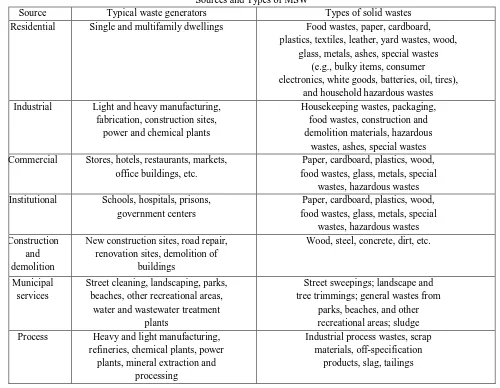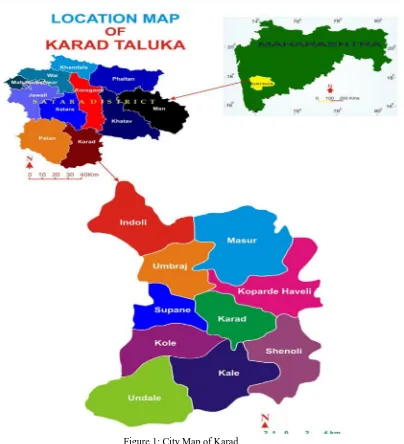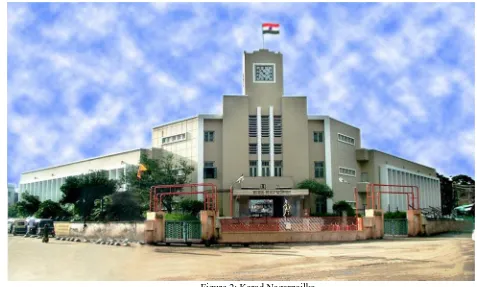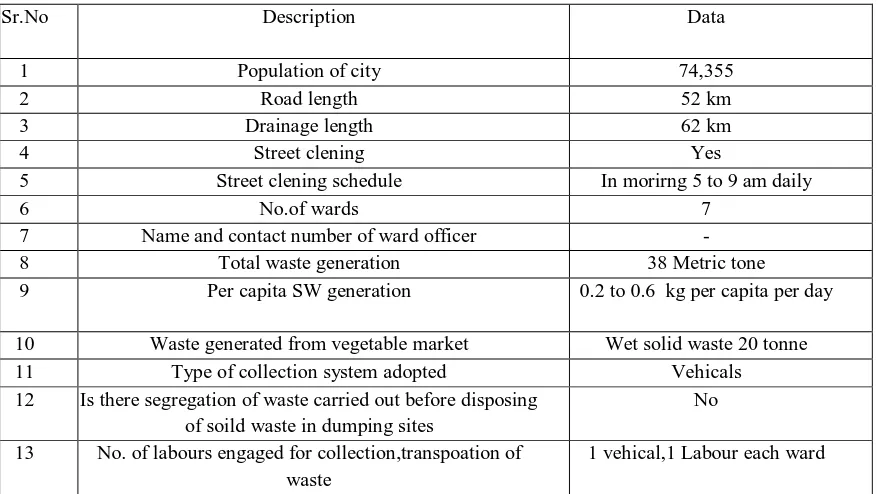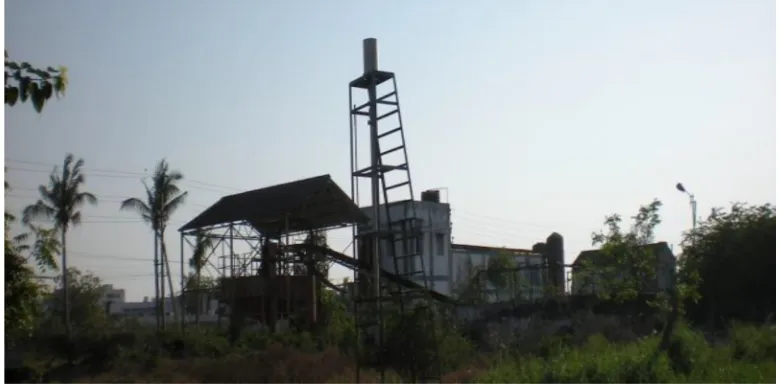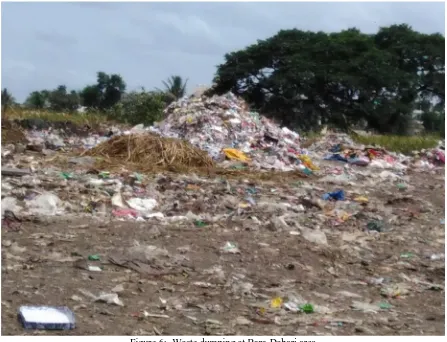Technology (IJRASET)
Disposal of Solid Waste For Landfilling In Karad
City A Review
Pooja T. Latake1, Amol Kulkarni2, Shrikant Bhosale3
1
Research Scholar, 2,3Assistant Professors, Environmental science Technology, Department of Technology, Shivaji University, Kolhapur, India
Abstract— Landfill considered as one of the most popular method of disposal of Municipal solid Waste in India. The typical composition of MSW in India is around 40-60%, of organic waste 30-40% of earthen materials paper, metals, plastics, leather etc. The municipal solid waste dispose in most of the landfills is done without segregation so it contains large amount of valuable materials in it. The municipal solid waste disposes in most of operational since more than 10 years or more. The municipal solid waste dispose in most of the landfills is done without segregation so it contains large amount of valuable materials.
Keywords— Current solid waste mangement in Karad city, sources of solid wast, Disposal of solid waste, suggestion, Process, conclusion.
I. INTRODUCTION
Due to rapid increase in the production and consumption processes, societies generate as well as reject solid materials regularly from various sectors -agricultural, commercial, domestic, industrial and institutional. The considerable volume of wastes thus generated and rejected is called solid wastes. India produces 42.0 million tons of municipal solid waste annually at present. Per capita generation of waste varies from 200 gm. to 600 gm. per capita / day. Average generation rate at 0.4 kg per capita per day in 0.1 million plus towns. Collection efficiency ranges between 50% to 90% of the solid waste generated. Nowadays consumption‑ driven society produces an enormous amount of waste. This large amount of waste puts huge pressures on the city authority to manage waste in a more sustainable manner. Waste management systems have not received as much nation in the city planning process as other sectors such as water or energy. Therefore, gaps can be observed in waste management in current city planning. Rapid industrialization and population explosion in India has led to the migration of people from villages to cities, which generate thousands of tons of MSW daily. The MSW amount is expected to increase significantly in the near future as the country strives to attain an industrialized nation status by the year 2020. Poor collection and inadequate transportation are responsible for the accumulation of MSW at every nook and corner. The management of MSW is going through a critical phase, due to the unavailability of suitable facilities to treat and dispose of the larger amount of MSW generated daily metropolitan cities. Unscientific disposal causes an adverse impact on all components of the environment and human health. (Rathi, 2006; Sharholy et al., 2005).
Technology (IJRASET)
generated from the landfills. the processes for leachate collection and treatment are complex and the costs are usually quite high .therefore the remedial and preventive measures cannot be undertaken at all the existing closed and the active landfill sites in one go because of the financial constraints. The remedial and preventive measures need to be taken up in a phased manner. (barjinder bhalla1, m.s. saini et al., 2014).
II. MSW CHARACTERIZATION
Municipal solid waste (MSW) is waste that comes from homes, businesses, and schools. Municipal solid waste does not include construction waste, industrial waste, or sewage waste.
MSW classification:-
A. By Material
what the waste is made of. Waste may be plastic, paper, metal, rubber, food waste, or yard waste. A plastic toy and plastic yogurt carton would be in the same materials category because they are both made of plastic.
B. By Product
what the waste was used for originally. The waste may be an old potato chip bag, a worn-out shoe, or a broken toy. A plastic beverage container and an aluminum beverage container would be in the same product category because they are both used as container.
[image:3.612.54.554.345.733.2]Knowledge of the sources and types of waste in an area is required in order to design and operate appropriate solid waste management systems (Table-1).
TABLE I
Sources and Types of MSW
Source Typical waste generators Types of solid wastes Residential Single and multifamily dwellings Food wastes, paper, cardboard,
plastics, textiles, leather, yard wastes, wood, glass, metals, ashes, special wastes
(e.g., bulky items, consumer electronics, white goods, batteries, oil, tires),
and household hazardous wastes Industrial Light and heavy manufacturing,
fabrication, construction sites, power and chemical plants
Housekeeping wastes, packaging, food wastes, construction and demolition materials, hazardous
wastes, ashes, special wastes Commercial Stores, hotels, restaurants, markets,
office buildings, etc.
Paper, cardboard, plastics, wood, food wastes, glass, metals, special
wastes, hazardous wastes Institutional Schools, hospitals, prisons,
government centers
Paper, cardboard, plastics, wood, food wastes, glass, metals, special
wastes, hazardous wastes Construction
and demolition
New construction sites, road repair, renovation sites, demolition of
buildings
Wood, steel, concrete, dirt, etc.
Municipal services
Street cleaning, landscaping, parks, beaches, other recreational areas,
water and wastewater treatment plants
Street sweepings; landscape and tree trimmings; general wastes from
parks, beaches, and other recreational areas; sludge Process Heavy and light manufacturing,
refineries, chemical plants, power plants, mineral extraction and
processing
Industrial process wastes, scrap materials, off-specification
Technology (IJRASET)
As is shown in the above table, MSW includes wastes generated from residential, commercial, industrial, institutional, construction, demolition, process, and municipal services. However, this definition varies greatly among waste studies, and some sources are commonly excluded, such as industrial, construction and demolition, and municipal services.
III. LITERATURE REVIEW
A. Introduction
Solid waste landfill, which is used for the safe disposal of solid waste generated in huge amount on daily basis, is the necessity of modern society. It helps in minimizing the issues related to public health and safety as well as adverse environment impact. Solid waste Landfills are broadly kept in two categories,
1) Conventional landfills: Conventional landfills are those landfills in which waste is dumped in layers and degradation under anaerobic conditions is allowed naturally. In order to protect the soil and ground water from contamination, liners are provided at the bottom of the landfill as well as in between as per the design requirements. The closing time for the conventional landfills is approximately 50-100 years depending on environment conditions as well as type of waste dumped and their degradation rate.
2) Engineered landfills : In the Engineered landfills, the leachate is collected at the bottom of the landfill and then recalculated in the landfill mass to expedite the process of degradation. Due to increased rate of bio-degradation, normal closing time of engineered landfill is reduced to 15-20 years. (Amit Srivastava et al., 2015).
Landfills are Engineered facilities for the disposal of:-
a) Municipal Solid Waste,
b) Hazardous Waste.
Following are the types of Engineered landfills:-
a) Above Ground landfill (Area landfill).
b) Below Ground landfill (Trench landfill).
c) Above &Below Ground landfill (sanitary landfill)
d) Slope landfill
e) Valley landfill.
B. Literature Review
Peter Kjeldsen, Morton A. Barlaz et.al. (2002) carried out review of Present and Long- Term Composition of MSW Landfill Leachate. They have reviewed of; the release of leachate to the environment is one of the major environmental impacts related to disposal of waste. Disposed waste in landfills undergoes a series of phases where the waste is decomposed. During the decomposition leachate is generated by excess rainwater infiltrating the waste. However, model calculations and a few laboratory experiments suggest that the enhanced release might not occur within a timeframe of several thousands of years.
Słomczyńska, T. Słomczyński (June 2004), carried out Physico-Chemical and Toxicological Characteristics of Leachates from MSW Landfills. They have reviewed of Leachate waters are formed as a result of the penetration of rainfall inside a landfill and the subsequent leaching of soluble organic and mineral compounds. As shown by the presented studies, physico-chemical characteristics of leachates change over the course of a landfill’s life. On so-called young landfills, the concentrations of pollutants in the leachates are high but as they age the value of BOD5/ COD ratio decreases.
Vijaya Singh et. al. (2008), studied One of the oldest and most common methods of municipal waste disposal is landfilling. This is most likely to remain the ultimate fate of solid waste since it appears to be one of the cheapest ways .Once disposed of in landfill; solid waste undergoes various physico-chemical and biological changes. Consequently, the degradation of the organic fraction of the wastes in combination with percolating rainwater leads to the generation of a highly contaminated liquid called leachate. The most commonly reported danger to the human health from these landfills is from the use of groundwater that has been contaminated by leachate.
Mufeed Sharholy, Kafeel Ahmad (2008), carried out, Municipal solid waste management in Indian cities, they have reviewed Municipal solid waste management (MSWM) is one of the major environmental problems of Indian cities. Improper management of municipal solid waste (MSW) causes hazards to inhabitants. Various studies reveal that about 90% of MSW is disposed of unscientifically in open dumps and landfills, creating problems to public health and the environment.
Technology (IJRASET)
have reviewed of the solid waste disposal system presently being practiced in Delhi consists of mere dumping of wastes generated, at three Locations Bhalaswa, Ghazipur, and Okhla without any regard to proper care for the protection of surrounding environment. Shao-gang Dong, Zhong-hua Tang.et.al. (2009), carried out Numerical modeling of the environment impact of landfill leachate leakage on groundwater quality-A field application, The basic input data for modeling the aquifer parameters includes topography, geometry, elevation, and soil properties of each soil layer in the aquifers.
Barjinder Bhalla, M.S. Saini, et.al. (2012), A Comparative Study of Characterization of Leachate from Municipal Solid Waste (MSW) Landfilling Sites of Ludhiana, India, They give a information of All the three landfilling sites of Ludhiana city are non-engineered low lying open dumps. They have neither any bottom liner nor any leachate collection and treatment system. Therefore, all the leachate generated finds its paths into the surrounding environment. Engineered landfill sites should be provided with impermeable liner and drainage system at the base of the landfill, which will not allow leachate to percolate into subsoil. All the leachate accumulated at the base of the landfill can be collected for recycling or treatment.
Pushpendra Singh Bundelaa, et.al (2012), evaluation of physicochemical parameter of municipal solid waste leachate at Jabalpur, They give to information of One of the major pollution problem caused by the municipal solid waste (MSW) landfill is leachate, which is generated as a consequence of precipitation, surface runoff and infiltration or intrusion of ground water percolating through a landfill. Generally leachate contain large amounts of organic matter (biodegradable but also refractory to biodegradation), which are great threat to the surroundings soil, groundwater even surface water. Besides contaminating surface water another divesting effect of dumping site is on groundwater quality by the formation of leachate. Leachate by seepages and infiltration not only deteriorates soil quantity but also renders the associated aquifer unreliable and until for drinking purposes. Therefore the present investigation deals with physicochemical analysis of municipal solid waste leachate in Jabalpur city.
Archana Chawla, Dr. S.K. Singh, (2014), carried out Modeling of Contaminant Transport from Landfills, They give, They give information of Mass transport of chloride and sodium from landfill leachate was modeled was taking into account the mechanism of contaminant transport advection and diffusion-dispersion and using the finite difference method with upwind correction. The model was solved and validated with the field data of solute transport (T.L.T. Zhan et al. 2014). Simulation of the validate model rum for two parameters. The possible uncertainties in the chloride source function, comparison of the field data and numerical results were considered to be good if the model simulation fit the declining concentrations in the top 2-3 m of the profile. For greater depths, their model results did not agree with the observed data and the sharp localized concentration changes identified beyond 3 m were attributed to the variations in the source concentration within the landfill and due to unidentified changes in local geochemistry. M.S. Saini et. al. (2014), Assessment of Municipal Solid Waste Landfill Leachate Treatment Efficiency by Leachate Pollution Index done by, India currently is facing a municipal solid waste dilemma, for which all elements of the society are responsible. The community sensitization and public awareness is low. There is no system of segregation of organic, inorganic and recyclable wastes at household level. There is an adequate legal framework existing in the country to address municipal solid waste management (MSWM). What is lacking is its implementation. In spite of a stringent legislation in place, open dumping is the most wide spread form of waste disposal. The possible reasons for poor implementation could be a combination of social, technical, institutional and financial issues. Public awareness, political will and public participation are essential for the successful implementation of the legal provisions and to have an integrated approach towards sustainable management of municipal solid wastes in the country.
Shashikanta Keisham, et al. (2015), A Review on the Recent Scenario of Municipal Solid Waste Management in India, They have studied that The rapid pace of increasing population, economic growth, urbanization and industrialization is coupled with accelerated solid waste generation. Waste generation has been a part and parcel of the development activities of mankind. Municipal Solid Waste (MSW) is an example of socioeconomic activities that entails with solid waste generation. Management of municipal solid waste is a national problem and is faced in all the cities of India. Two of the major problems being encountered are the insufficient collectionand inappropriate final disposal of MSW.
IV. METHODOLOGY
A. To study the solid waste generation, in karad city.
B. Primary data will be collected, from Karad Municipal Corporation, Websites, and other agencies.
C. For studying of solid waste collection, transportation, processing and disposal in karad city.
D. To suggest an efficient system having the ability to collect, manage and dispose solidWaste properly in Karad City.
Technology (IJRASET)
A. To study the solid waste generation, in karad city:-
1) About Karad city: Karad is a city in Satara district in the southern part of Indian state of Maharashtra. It lies at the confluence of Koyna River and the Krishna River. The two rivers originate at Mahabaleshwar, which is around 100 km from Karad. They diverge at their origin, and travel for about the same distance to meet again in Karad. The rivers meet exactly head on, thus forming letter "T" which is the only head on confluence in the world. Hence their confluence is called Preeti Sangam, meaning Confluence of Love. Karad is well known for sugar production and is known as the sugar bowl of Maharashtra owing to the presence of many sugar factories in and around Karad. It is considered as an important educational hub in Western Maharashtra due to the presence of many prestigious educational institutes. Karad has an adjoining small town named Malkapur. Karad city was awarded a prize under "Sant Gadagebaba Gramswachatta Abhiyan" started by Indian Government.
2) Demographics: As of 2011 India census, Karad City had total population of 74,355. Males constitute 52% of the population and females 48%. Karad has an average literacy rate of 76%, higher than the national average of 59.5%: male literacy is 80%, and female literacy is 72%. In Karad, 11% of the population is under 6 years of age. People are well educated and sophisticated having very high per capita income and high living standards. People from different cultures live here but vast majority belong to Hinduism and Speak Marathi language.
[image:6.612.124.528.277.721.2]The city map of Karad is given in Figure:-
Technology (IJRASET)
[image:7.612.65.542.88.375.2]3) Nagarpalika:
Figure 2: Karad Nagarpailka.
Karad Nagarpalika was established in 1965.And they are situted in Bhudhvar pet karad. Mr. Vinayak Aundhkar sir is chief Excutive Engineer Officer at these Nagarpailka.And Mr.Devand Jagtap sir is sanitary Inspecter in these Nagarpalika.Mr. Ashok Pawar sir is Civil Engineer at these Nagarpalika They give me a valuable information about all city solid waste generation,collection,and Disposal.Which heplful in my project report. Karad City is one of the important City in Satara district. It is situated on confluence of Krishna and Koyana River. The City extends between 17 018’ north to 17038’ north latitude and 73 052’east to 74 016’ east longitude.
4) Waste Generation in Karad city: In Karad city,daily overall waste generated is 38 Metric tonne. Out of this 5 metric tonne waste is organic waste which is coming from all hotels and houses.And this 5 MT organic waste is given to BARC for generation of biogas. All organic waste is collected seperately, and it is transported to biogas plant for further processing. Remaning 33 MT inorganic waste is dumped at Bara-Dabari area which is outside the city.This inorganic waste which is dumped outside city it is huge problem for cite and Nagrpailka. This waste is distrubing the surrounding Environment and health of their peoples.Thats why proper management is required for this waste. So I suggest to Nagarpalika for further processing on inorganic waste by using landfilling. Increment in waste generation rate is 10% per annum.
Table NO:-4 Waste generation in Karad City.
Years
Waste generated in per day
MT
waste generated
yearly in MT
20% rejected volume
Total volume
m³
10% Increased
2016 38 13870 2774.0 3467.5 3814.25
2017 38.8 14147 2829.5 3537 3891
2018 39.5 14430 2886.1 3608 3968
2019 40.3 14719 2943.8 3679.74 4048
2020 41.1 15013 3002.7 3753 4129
Technology (IJRASET)
5) Composition of waste: The quantity as well as its composition (biodegradable, recyclables etc.) is required to arrive at proper technology (IES) for waste processing, viz. Compositing (CC), Biomethanation (BM), Waste to Energy (WTE), Landfilling etc. An analysis of the composition of solid wastes is essential for the following reasons:
It provides the basic data on which the management system is planned, designed and operated
a) The changes/trend in composition and quantity of waste over a period of time are known which help in future planning.
b) It provides the information for the selection of equipment and appropriate technology.
c) It indicates the amount and type of material suitable for processing, recovery and recycling.
[image:8.612.88.527.474.721.2]d) The forecast trends assist designers and manufacturers in the production of vehicles and equipment suitable for future needs. For such information to be of the widest possible benefit it must be collected by a responsible national, regional or local authority and made available to all who require it.
Table No:-5 Comopostion of Waste
Material Average
tonnes/day
Range tonnes/day
Paper 7.58 8.36 – 13.05
Metals 9.06 1.21 – 17.53
Glass 8.28 1.02 – 16.11
Plastics 5.60 0.60 – 3.21
Other ( electronics construction and demolition
etc).
3.00 2.7 – 5.04
Organic waste 5.00 -
B. Primary data collected, from Karad Municipal Corporation
All primary data was collected in Kadar Municipal Corporation.Mr. Ashok Pawar sir is Civil Engineer at these Nagarpailka. He give me data about all solid waste collection,transpotaion,processing and disposal of waste in overall city. This study I have seen that solid waste generation increasing rapidly, in day to day life solid waste increasing rapidly in this city, and it’s adverse impacts on environment. In Karad city generation of solid waste is higher as compared to population of city. And it is problem to disposal of waste, so in this city it is very needful to management of solid waste.
Data collection sheet
Sr.No Description Data
1 Population of city 74,355
2 Road length 52 km
3 Drainage length 62 km
4 Street clening Yes
5 Street clening schedule In morirng 5 to 9 am daily
6 No.of wards 7
7 Name and contact number of ward officer -
8 Total waste generation 38 Metric tone
9 Per capita SW generation 0.2 to 0.6 kg per capita per day
10 Waste generated from vegetable market Wet solid waste 20 tonne
11 Type of collection system adopted Vehicals
12 Is there segregation of waste carried out before disposing of soild waste in dumping sites
No
13 No. of labours engaged for collection,transpoation of waste
Technology (IJRASET)
14 No. of vehicals used for collection,transpotion according to thir type
10 auto-rikshas 3 chotta hatti
1 tractor
1-tractor for only organic waste only
15 Location of dumping site Bara-Dabari area
16 Dumping site under operation since Past 50 yrs
17 Area of dumping site 6.5 Hectors,2km away from city
18 Amount of waste dumped daily in tones 38 MT
19 Is their proceesing is carried out No
20 Is there any future proposal for proceesing Only organic waste-Biometnation is starting
21 Is there site available for future expansion No
22 Is there latest DPR is available No
23 Is there any maps available of SWM site No
24 Numbers of hotels available in area 84
25 Expenses on SWM in 2015-16 In corors
26 Sewage treatment plant is available Yes.7.5 MLD plant in working condition
C. For Studying Of Solid Waste Collection, Transportation, Processing And Disposal In Karad City
1) Collections: The all city solid waste is collected through each vehicles on each ward. The Waste is collected at regular intervals in all city. It is recommended to have a mechanism for door to door collection of waste from the staff/ labour colonies and labour sheds. The sanitary workers / sweepers) will have tricycle with containers or containerized handcarts having ringing bell and will go for waste collection from individual house at a fixed time every day. The sanitary workers would ring the bells at the time of reaching the particular area/locality, giving a signal for waste collection to the residents.
a) In labour colonies also, the door-to-door collection of waste would be carried out. The containerized rickshaws or handcarts would be employed for collection of wastes. The labourers should be strictly advised to store the wastes in available plastic containers of suitable size. The waste bins including community bins are to be cleaned daily by the sanitary workers at an informed timing.
[image:9.612.92.523.519.713.2]b) During collection of wastes from the bins, care shall be taken to avoid waste spillage and it shall be the responsibility of the sanitary workers to clean & maintain hygienic conditions at the places where community bins are kept.
Technology (IJRASET)
2) Transportation: The collated waste is transported in Tractor or auto-rikshas,and it is send to the final disposal. The organic and inorganic waste is transported separately.It is recommended to use tricycles/push carts/containerized handcarts, for primary collection of waste from the individual households, offices and other public places, as described above, up to the waste storage depots. The sufficient number of tri-cycles / push carts/containerized handcarts shall be arranged for effective door-to-door collection system.
a) The wastes collected from the street sweeping & drain cleaning is to be shifted to the waste storage depots using tricycles/handcarts.
b) The transportation of waste from the waste storage depots to the processing and disposal sites will be done in the covered trucks/dumpers etc. so that the waste is not exposed to the human population and there is no spillage of waste on the roads during transportation.
[image:10.612.115.528.238.422.2]c) To take care of certain unavoidable circumstances, if it is required to lift waste from some open place, front-end loaders and tractor trolleys may be used.
Figure 4:-Waste Transport station at Karad city
C.Processing
Out of 38 Metric tone 5 tone waste generated is orgainc waste.so these organic waste is processing on Biogas plant.The BARC got these tender. With the implementation of source segregation and door-to-door collection system, processing of the waste would be easier. SWMC shall invite interested parties who can take the segregated waste and establish suitable waste processing plant
(Biogas plant). The rejects from the processing plant and non-recyclable and other wastes would be directly dumped off in dumping site.
[image:10.612.111.501.514.706.2]Technology (IJRASET)
D. Disposal
[image:11.612.83.530.115.457.2]The solid waste is dumped in Bara-Dabari area.It is area is 4 km away from karad city.and it is 6.5 hectors in area.Only Organic waste is seperted .and remaining all inorganic waste is openly dumped in this Bara-Dabari area.
Figure 6:- Waste dumping at Bara-Dabari area
V. CONCLUSIONS
In Karad city solid waste separated at regular intervals. But organic waste is processing on Biogas plant.The BARC got these tender.There is no any treatment or disposal method for Inorganic or non-biodegradable waste. So proper treatment and disposal method is necessary for this waste.
VI. SUGGESTIONS
I would like to suggest Landfilling should be constructed for other Inorganic waste.
REFERENCES
[1] Peter Kjeldsen, Morton A. Barlaz Alix P. Rooker,2 Anders Baun,' Anna Ledin,' And Thomas H. Christensen (2002), “A Review Present And Long-Term Composition Of MSW Landfill Leachate,” Critical Reviews In Environmental Science And Technology, 32(4):297-336.
[2] B. Słomczyńska, T. Słomczyński (2004), “A Review Of Physico-Chemical And Toxicological Characteristics Of Leachates From MSW Landfills,” Polish Journal Of Environmental Studies, Vol. 13, No. 6 (2004), 627-637.
[3] Vijaya Singh And Atul. K. Mittal (2008), “A Case Study Of Okhla Landfill Delhi: Groundwater Pollution By Municipal Solid Waste Landfill Leachate,” Environmental Science And Technology, 1-10.
[4] Mufeed Sharholy, Kafeel Ahmad, Gauhar Mahmood , R.C. Trivedi ( 2008), “A Review Of Municipal Solid Waste Management In Indian Cities”, Waste Management 28 ,459–467.
[5] Bharat Jhamnani And SK Singh (2009),”Groundwater Contamination Due To Bhalaswa Landfill Site In New Delhi”, International Journal Of Civil And Environmental Engineering, 1:3.
[6] Shao-Gang Dong, Zhong-Hua Tang, Bai-Wei Liu,( 2009), “Numerical Modeling Of The Environment Impact Of Landfill Leachate Leakage On Groundwater Quality-A Field Application”, International Conference On Environmental Science And Information Application Technology ,978-0-7695-3682-8/09.
[7] Enete Ifeanyi Christian (2010), “Potential Impacts Of Climate Change On Solid Waste Management In Nigeria,”Abbreviation Of Institute OfElectrical
Technology (IJRASET)
[8] Barjinder Bhalla, M.S. Saini, M.K. Jha (2012), “A Comparative Study Of Characterization Of Leachate From Municipal Solid Waste (MSW) Landfilling Sites Of Ludhiana, India”, International Journal Of Engineering Research And Applications (IJERA), ISSN: 2248-9622.
[9] Pushpendra Singh Bundela, Akhilesh Kumar Pandey, Jamaluddinc, Abhishek Kumar Awasthi And Priyanka Pandey (2012), Evaluation Of Physicochemical Parameter Of Municipal Solid Waste Leachate At Jabalpur”, International Journals Of Plant, Animals And Environmental Sciences”, Volume -2,Issue-1.ISSN 2231-4490.
[10] Archana Chawla1, Dr. S.K. Singh (2014), “Modeling Of Contaminant Transport From Landfills”, International Journal Of Engineering Science And Innovative Technology (IJESIT) , 222-227.
[11] M.S. Saini2, M.K. Jha, Barjinder Bhalla (2014), “Assessment Of Municipal Solid Waste Landfill Leachate Treatment Efficiency By Leachate Pollution Index,”International Journal Of Innovative Research In Science, Engineering And Technology (IJIRSET), 8447-8449.
[12] Shashikanta Keisham, Dr Biswajit Paul (2015), “A Review On The Recent Scenario Of Municipal Solid Waste Management In India”, International Journal
Of Engineering Research And General Science, Volume 3, Issue 3, ISSN 2091-2730.
[13] Text Book Of “State Of The Art Review Landfill Leachate Treatment”, By Environmental Engineering And Management, School Of Environment, Resources And Development, Asian Institute Of Technology, 3-15.
[14] Text Book Of “Guidelines For The Design, Construction And Operation Of Manual Sanitary Landfills”, By Jorge Jaramillo Universidad De Antioquia, Colombia, 1-17.
[15] WWW. Wikipedia. Landfill.Com.
[16] Superfund Landfill Methane-To-Energy Pilot Project, United States Environmental Protection Agency Washington.
[17] Detailed Project Report For Municipal Solid WasteManagement (Mswm) In Vijayawada, Andhra Pradesh (AP).
[18] Solid Waste Management Manual.
